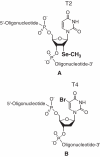Selenium derivatization of nucleic acids for crystallography
- PMID: 17169989
- PMCID: PMC1802610
- DOI: 10.1093/nar/gkl1070
Selenium derivatization of nucleic acids for crystallography
Abstract
The high-resolution structure of the DNA (5'-GTGTACA-C-3') with the selenium derivatization at the 2'-position of T2 was determined via MAD and SAD phasing. The selenium-derivatized structure (1.28 A resolution) with the 2'-Se modification in the minor groove is isomorphorous to the native structure (2.0 A). To directly compare with the conventional bromine derivatization, we incorporated bromine into the 5-postion of T4, determined the bromine-derivatized DNA structure at 1.5 A resolution, and found that the local backbone torsion angles and solvent hydration patterns were altered in the structure with the Br incorporation in the major groove. Furthermore, while the native and Br-derivatized DNAs needed over a week to form reasonable-size crystals, we observed that the Se-derivatized DNAs grew crystals overnight with high-diffraction quality, suggesting that the Se derivatization facilitated the crystal formation. In addition, the Se-derivatized DNA sequences crystallized under a broader range of buffer conditions, and generally had a faster crystal growth rate. Our experimental results indicate that the selenium derivatization of DNAs may facilitate the determination of nucleic acid X-ray crystal structures in phasing and high-quality crystal growth. In addition, our results suggest that the Se derivatization can be an alternative to the conventional Br derivatization.
Figures






Similar articles
-
Selenium derivatization of nucleic acids for X-ray crystal-structure and function studies.Chem Biodivers. 2010 Apr;7(4):753-85. doi: 10.1002/cbdv.200900200. Chem Biodivers. 2010. PMID: 20397215 Review.
-
Nucleic acid X-ray crystallography via direct selenium derivatization.Chem Soc Rev. 2011 Sep;40(9):4591-602. doi: 10.1039/c1cs15020k. Epub 2011 Jun 13. Chem Soc Rev. 2011. PMID: 21666919 Review.
-
Novel complex MAD phasing and RNase H structural insights using selenium oligonucleotides.Acta Crystallogr D Biol Crystallogr. 2014 Feb;70(Pt 2):354-61. doi: 10.1107/S1399004713027922. Epub 2014 Jan 29. Acta Crystallogr D Biol Crystallogr. 2014. PMID: 24531469 Free PMC article.
-
Synthesis of a 2'-Se-thymidine phosphoramidite and its incorporation into oligonucleotides for crystal structure study.Org Lett. 2007 Mar 1;9(5):749-52. doi: 10.1021/ol062937w. Epub 2007 Jan 31. Org Lett. 2007. PMID: 17263541 Free PMC article.
-
Selenium derivatization and crystallization of DNA and RNA oligonucleotides for X-ray crystallography using multiple anomalous dispersion.Nucleic Acids Res. 2004 Mar 8;32(5):1638-46. doi: 10.1093/nar/gkh325. Print 2004. Nucleic Acids Res. 2004. PMID: 15007109 Free PMC article.
Cited by
-
Synthesis of 6-Se-guanosine RNAs for structural study.Org Lett. 2013 Aug 2;15(15):3934-7. doi: 10.1021/ol401698n. Epub 2013 Jul 16. Org Lett. 2013. PMID: 23859218 Free PMC article.
-
Construction and structure studies of DNA-bipyridine complexes as versatile scaffolds for site-specific incorporation of metal ions into DNA.J Biomol Struct Dyn. 2019 Feb;37(3):551-561. doi: 10.1080/07391102.2018.1441071. Epub 2018 Feb 22. J Biomol Struct Dyn. 2019. PMID: 29447072 Free PMC article.
-
Structure-based DNA-targeting strategies with small molecule ligands for drug discovery.Med Res Rev. 2013 Sep;33(5):1119-73. doi: 10.1002/med.21278. Epub 2013 Apr 30. Med Res Rev. 2013. PMID: 23633219 Free PMC article. Review.
-
A fast selenium derivatization strategy for crystallization and phasing of RNA structures.RNA. 2009 Apr;15(4):707-15. doi: 10.1261/rna.1499309. Epub 2009 Feb 18. RNA. 2009. PMID: 19228585 Free PMC article.
-
Facile synthesis of nucleoside 5'-(α-P-seleno)-triphosphates and phosphoroselenoate RNA transcription.RNA. 2011 Oct;17(10):1932-8. doi: 10.1261/rna.2719311. Epub 2011 Aug 26. RNA. 2011. PMID: 21873462 Free PMC article.
References
-
- MacRae I.J., Zhou K., Li F., Repic A., Brooks A.N., Cande W.Z., Adams P.D., Doudna J.A. Structural basis for double-stranded RNA processing by Dicer. Science. 2006;311:195–198. - PubMed
-
- Jacobs S.A., Podell E.R., Cech T.R. Crystal structure of the essential N-terminal domain of telomerase reverse transcriptase. Nature Struct. Mol. Biol. 2006;13:218–225. - PubMed
-
- Adams P.L., Stahley M.R., Kosek A.B., Wang J., Strobel S.A. Crystal structure of a self-splicing group I intron with both exons. Nature. 2004;430:45–50. - PubMed
-
- Parkinson G.N., Lee M.P.H., Neidle S. Crystal structure of parallel quadruplexes from human telomeric DNA. Nature. 2002;417:876–880. - PubMed
-
- Peersen O.B., Ruggles J.A., Schultz S.C. Dimeric structure of the Oxytricha nova telomere end-binding protein alpha-subunit bound to ssDNA. Nature Struct. Biol. 2002;9:182–187. - PubMed
Publication types
MeSH terms
Substances
Associated data
- Actions
- Actions
- Actions
- Actions
LinkOut - more resources
Full Text Sources
Other Literature Sources

